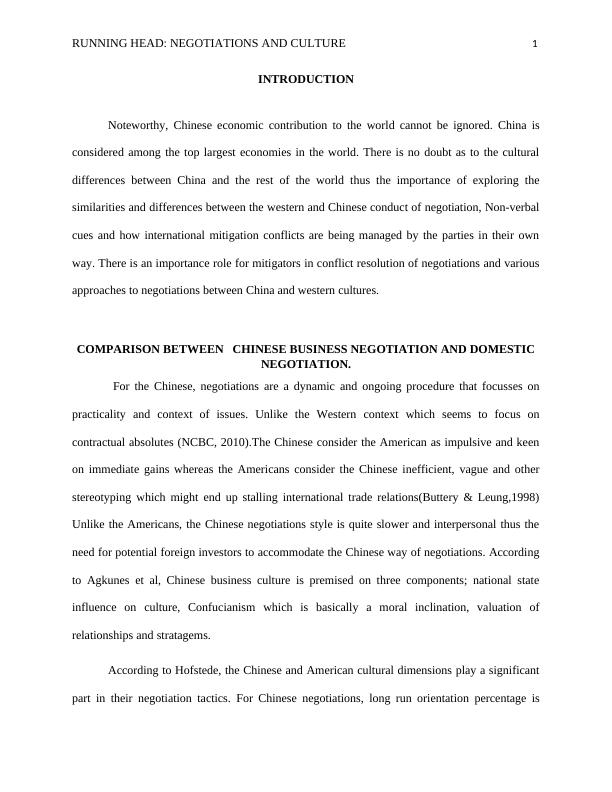Negotiating and Culture Assignment Sample
11 Pages2445 Words44 Views
Added on 2021-04-17
Negotiating and Culture Assignment Sample
Added on 2021-04-17
ShareRelated Documents
International BusinessNameInstitution

RUNNING HEAD: NEGOTIATIONS AND CULTURE 1INTRODUCTIONNoteworthy, Chinese economic contribution to the world cannot be ignored. China isconsidered among the top largest economies in the world. There is no doubt as to the culturaldifferences between China and the rest of the world thus the importance of exploring thesimilarities and differences between the western and Chinese conduct of negotiation, Non-verbalcues and how international mitigation conflicts are being managed by the parties in their ownway. There is an importance role for mitigators in conflict resolution of negotiations and variousapproaches to negotiations between China and western cultures.COMPARISON BETWEEN CHINESE BUSINESS NEGOTIATION AND DOMESTICNEGOTIATION.For the Chinese, negotiations are a dynamic and ongoing procedure that focusses onpracticality and context of issues. Unlike the Western context which seems to focus oncontractual absolutes (NCBC, 2010).The Chinese consider the American as impulsive and keenon immediate gains whereas the Americans consider the Chinese inefficient, vague and otherstereotyping which might end up stalling international trade relations(Buttery & Leung,1998)Unlike the Americans, the Chinese negotiations style is quite slower and interpersonal thus theneed for potential foreign investors to accommodate the Chinese way of negotiations. Accordingto Agkunes et al, Chinese business culture is premised on three components; national stateinfluence on culture, Confucianism which is basically a moral inclination, valuation ofrelationships and stratagems. According to Hofstede, the Chinese and American cultural dimensions play a significantpart in their negotiation tactics. For Chinese negotiations, long run orientation percentage is

RUNNING HEAD: NEGOTIATIONS AND CULTURE 2higher as compared to the American orientation in the long run. Also during negotiations,China’s power distance is higher than that of the United States of America (“The shape ofChinese..,2016).In the U.S.A, most companies send representatives such as sales executives ascontrasted with the hierarchical and seniority societal tendencies of the Chinese. Primarily, theAmerican Chinese negotiation styles differ on four major fronts. Persuasions approaches,agreement terms, exchange of information and non –task sounding(Yangfang,2017).Majorly,Chinese negotiations are entered into with the aim of establishing a long-term workingrelationship as compared to the Western culture of negotiations. In Chinese information, flow along a hierarchical standing, authority, and seniority unlikethe American system which solely focusses on authority .In terms of negotiations, the Americanapproach comes off as aggressive as compared to China’s.(Do,2015). COMPARISON BETWEEN WESTERN AND CHINESE NON VERBAL COMMUNICATION DURING CHINESE NEGOTIATIONS. Undeniably, there are different meanings to the non-verbal cues between Eastern andWestern Countries thus the need to explore the dynamics for better business relations(‘’Theshaping of Chinese n.d.)For the Western negotiators, eye contact is a good thing. It illustratesconcentration and good will. However, the same cannot be said for the Chinese population, tothem, avoidance of eye contact is the utmost show of respect (Akgunes et.al, 1998).For theChinese, constant eye contact with negotiators, is unwarranted and is seen as a stare rather than ashow of interest or goodwill (UCSBC, 2010)This simple but crucial nonverbal clue should benoted by both western and Chinese negotiators to avoid misunderstandings.

RUNNING HEAD: NEGOTIATIONS AND CULTURE 3 Predominantly, the Chinese projection of negative views is illustrated through a leaned-back body posture and more eye contact. For the Canadian counterpart, an illustration ofnegative views is followed by gaze aversion (Azad and Adair, 2011).Following a survey on thenonverbal communication between Chinese and Canadian participants, it was concluded that forthe Canadians, a show of dominance is projected through negative body posture and movementas compared with positive postures and movements. The same negative posture and bodymovement were likely to be adopted by the Chinese participants under the survey .For a show ofdominance, Canadians are likely to sit upright. However, for the Chinese, upright sitting is proofof submission.Also, for the Chinese societal expectations, the most used feature in non-verbalcommunication is the eyes. However, for most American or western cultures, the most usednonverbal cue is the mouth (Sites at Penn, n.d).For the Western lost, especially the Americans,facial expressions are communicated through the smiles and frowns by the mouth. These facts goto show how different the Eastern and Western cultures project their nonverbal cue. Anothercritical nonverbal cue is the use of the finger on the mouth as a hush or silences body language.Whilst this finger movement is approved among many western circles, the Chines regard thisfigure movement with disdain and disapproval thus the need for western negotiators to avoid it.Primarily, non –verbal communication comprise of Kinesiology, paralanguage andenvironmental language. Chinese culture makes its negotiators to adopt a high context culture ascontrasted with the American, whose cultural approach is low context (Yangfung, 2017).ForChinese negotiators, the emphasis lies in the context, physical or social. Chinese nonverbal cuesare considered modest and restrained. The western nonverbal cues are guided by the contentrather than how it was delivered. Simply, American negotiator actions are direct thus

End of preview
Want to access all the pages? Upload your documents or become a member.
Related Documents
Cultural Traits and Business Negotiations in Chinalg...
|12
|550
|72
Cultural Intelligence in Companieslg...
|8
|1854
|440
